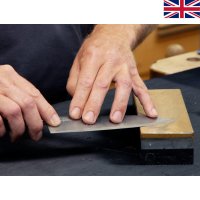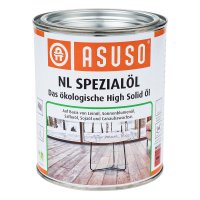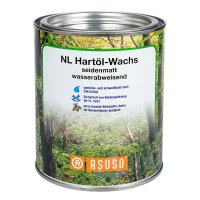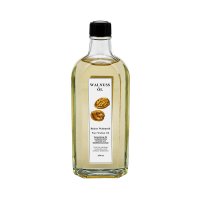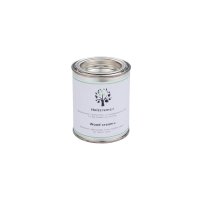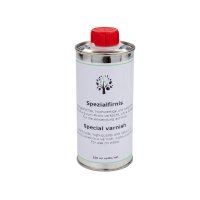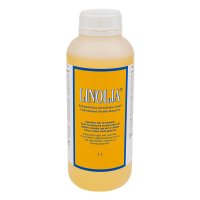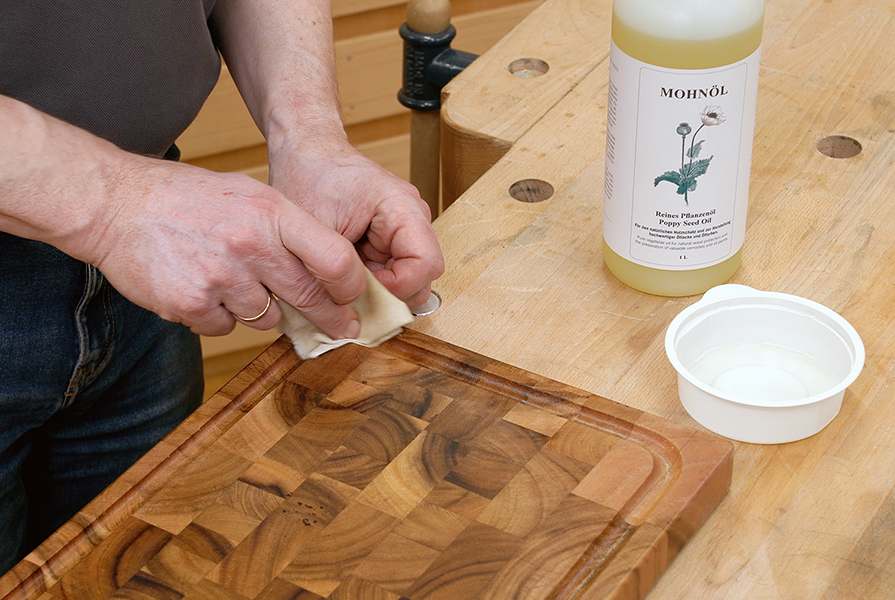
Beautiful, large wooden chopping boards are the ideal cutting surface as they are gentle on the blades of your kitchen knives. Many types of wood have antibacterial properties, making them perfect for use in the kitchen. Both plastic and wood cutting surfaces are popular in the kitchen. If you want to put the board in the dishwasher, you should go for plastic. If you are looking for a natural, decorative material, choose wood. However, over time, the cutting of food leaves its mark on the wooden surface. Here you can find out how to properly protect, maintain and restore your wooden chopping boards as well as your kitchen worktops.
How are new chopping boards prepared for use?
It’s easy to prepare new wooden chopping boards for use in the kitchen. Home-made chopping boards should be carefully sanded down to finish them off (at least to 360 grit) or, better still, planed by hand. Planing creates a »closed« surface, whereas sanding leaves behind loose fibres. You can then apply a suitable oil - more on this in a moment!
How can used chopping boards be restored?
Reconditioning chopping boards that have been used for a long time is a little more complex. First clean the board with hot water and, if necessary, a little washing-up liquid. But be careful, soap can prevent the oil that is applied later from hardening! Dry the board thoroughly and leave to fully dry for a few hours.
If cooking oils and fats have penetrated the wood over time, sanding can be very difficult as the sandpaper will quickly become clogged. If this is the case, honing the surface with a well-sharpened scraper blade is much more effective. This allows you to quickly remove rough patches and to work on specific areas in a targeted manner. To finish, you need to remove all dust before oiling the board.
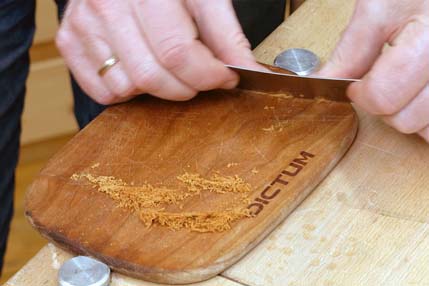
A scraper blade makes it easy to remove unsightly spots
Do chopping boards need to be oiled?
Chopping boards don’t necessarily need to be oiled. Some types of wood have a high oil content and are thus naturally protected against moisture (e.g. olive wood, acacia wood). However, in the long run it’s good for any wood to be treated to achieve more permanent moisture protection. The oil penetrates the open structure of the wood and provides natural protection against fats and plant juices. This eliminates or at least reduces the likelihood of food residue sticking to the board. Oiled chopping boards are thus also easier to clean than untreated ones.
Contrary to popular belief, oil does not seal the pores in the wood. Instead, it preserves the porosity of the wood. When wood is sealed, it’s more likely to crack. It’s also worth noting that the hygroscopic properties of wood are important for hygiene. Wood has the ability to absorb and release moisture. Bacteria don’t like constantly changing environmental conditions. In addition, many types of wood have antibacterial components, such as the tannic acid in oak.
Which oils are suitable for chopping boards?
This is where opinions differ. It is often claimed that simple cooking oils such as sunflower oil or olive oil can be used. This is not advisable for two reasons:
1. Most cooking oils don’t offer permanent protection because they don’t harden. They remain permanently liquid and are easily washed off during cleaning. If you use ordinary cooking oil on your chopping board, you will have to keep re-oiling it.
2. Many cooking oils turn rancid. The often-mentioned olive oil is particularly susceptible to this. The smell and especially the taste will affect food quality.
You can use all food-safe self-hardening plant oils on chopping boards, provided they don’t contain chemical additives (especially siccatives). One such suitable oil, which is also used for cooking, is linseed oil. Linseed oil is a so-called »hardening oil« and thus provides permanent protection. However, pure linseed oil hardens relatively slowly. The following plant oils are particularly suitable for chopping boards and kitchen worktops:
Linolja® Organic Swedish Linseed Oil, cold bleached
The oil is cold-pressed from linseeds and used for environmentally friendly wood protection. Due to pre-oxidation, the drying properties of this low-viscosity oil are significantly improved. The treatment also lightly bleaches the oil. Linolja can be used directly as it is.
König Holz & Harz Special Varnish
This special varnish made from linseed and tung oil contains no additives and is produced through a complex process, using pure natural and renewable raw materials. The oil mixture is gently heated, allowing pre-oxidation to take place. In contrast to raw linseed and tung oil, the resulting special varnish can already be polished after 24 hours. Ideal for achieving deep matt, hard-wearing, UV-stable and water-repellent surfaces. This varnish is suitable for bowls, plates, writing utensils and furniture. Outdoors it can be used for wooden benches, tables and wood facades requiring a weather-resistant finish.
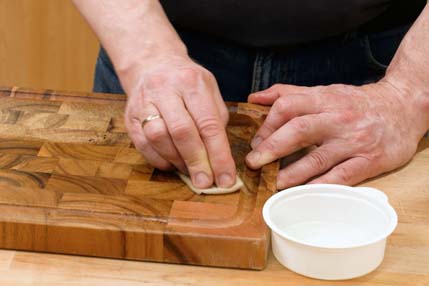
When oiling a chopping board, always apply the oil thinly in several layers
The special varnish can be polished after 24 hours as opposed to raw linseed and tung oil due to gentle heating of the oil mixture. Ideal if you want to achieve a deep matte, durable, UV-stable and water-repellent surface. The special varnish is suitable for bowls, plates, writing instruments, furniture or outdoor benches, tables and wooden facades that need to be weather resistant.
Note: Pure tung oil (e.g. Lignea) has a distinctive smell that disappears after drying. Because of its odour, we don’t recommend it for chopping boards, but it’s a useful component in oil mixtures to achieve better surface hardening.
Refined Walnut Oil
Walnut oil is the only hardening nut oil!
Made from 100 % Californian walnuts, this cold pressed food-grade oil is the only nut oil suitable for surface protection. In terms of both its chemical structure as well as its properties, walnut kernel oil sits between linseed oil and poppy seed oil. It has a significantly shorter drying time than poppy seed oil and a low tendency to yellowing. Ideal for handcrafted objects, woodturning items, toys, kitchen furniture and kitchen utensils. It creates an easy to grip surface, making it especially ideal for knife and tool handles.
Poppy Seed Oil
This food-safe oil is extracted from the seeds of the white poppy flower (Papaver somniferum). The high transparency of poppy seed oil makes it the perfect base for violin varnishes and clear protective wood finishes. It provides excellent protection against moisture and dirt, does not turn yellow and penetrates deeply into the wood for a firm surface. However, poppy seed oil dries much slower than raw linseed oil. Application of multiple coats results in a warm, silky sheen and a surface which is pleasant to the touch. Poppy seed oil is ideal for arts and crafts items, turned objects, toys, kitchen furniture and kitchen utensils.
What should I bear in mind when oiling chopping boards?
If you want to oil your wooden chopping board and have decided on a suitable oil, please observe the following points:
- The chopping board must be clean and dry.
- Always apply oil very thinly, preferably with a cloth or sponge.
- Leave the oil to soak in for a maximum of 15 minutes and then wipe off any excess (pools of oil).
- Several thin coats will give better protection than one thick coat.
- Leave the chopping board to dry in a sunny place. Most oils require UV light to cure.
Tips for caring for wooden chopping boards
- Clean immediately after use to prevent incrustation.
- Use only hot water and normal washing-up liquid to clean.
- Wipe or brush down the surface, never soak the board in water.
- Always wipe both sides of the chopping board with a damp cloth to prevent warping.
- Never put wooden chopping boards in the dishwasher!
- After cleaning, thoroughly wipe dry and leave to fully dry in an upright position.
Surface treatment for kitchen worktops
You can also use the previously mentioned oils for your wooden kitchen worktops. However, as chopping and food preparation are rarely carried out directly on the worktop itself, protection against moisture and the surface finish (matt, satin or gloss) are the most important aspects to consider for kitchen worktops. In addition to the oils mentioned above, you can use other surface agents that offer better and longer-lasting protection against moisture and allow you to achieve the desired appearance.
Suitable surface protection for kitchen worktops
For wood worktops, you ideally want to use oil blends that are slightly more durable than pure oils. Other ingredients, especially natural waxes, are often added to determine the gloss and hardness of the surface. Here are a few examples of suitable products:
König Wood & Resin Wood Cream Plus
Wood Cream+ can be used to achieve food-safe, water-repellent surfaces on worktops and other items in the household that come into contact with liquids. Wood Cream+ gives the wood surface a silky matt, natural shine and consists of natural oils, waxes and resins. The oil penetrates deep into the wood pores and strengthens them as it cures, while the beeswax and tree resin create a stable, elastic, dirt- and water-repellent layer on the wood surface.
ASUSO® NL Hard Oil Wax, water-repellent, Silk Matt
A combination of the beneficial properties of plant oil and the characteristics of natural waxes. This hard-wax oil is ideal for protecting heavy-wear indoor surfaces made of wood. The fine wax layer makes the surface especially easy to clean.
ASUSO® NL Special Oil
Breathable waterproofing based on linseed oil, sunflower oil, safflower oil, soy bean oil and carnauba wax. Easily penetrates into the pores and provides an elastic yet hard and wear-resistant natural surface finish on untreated and stripped wood in indoor areas. Highly resistant to dirt, water and wear.

